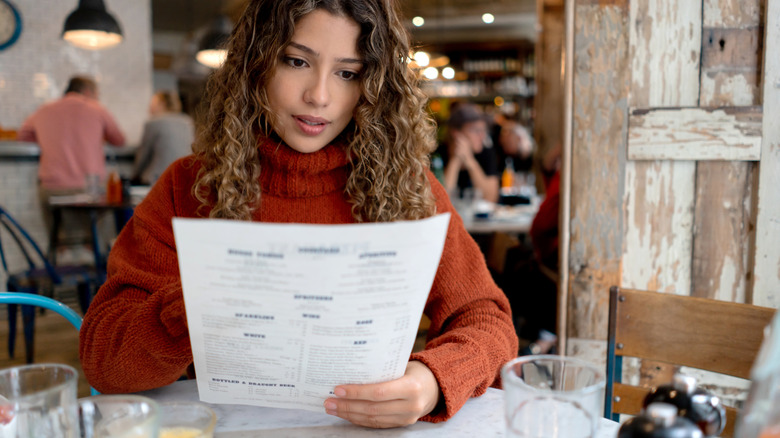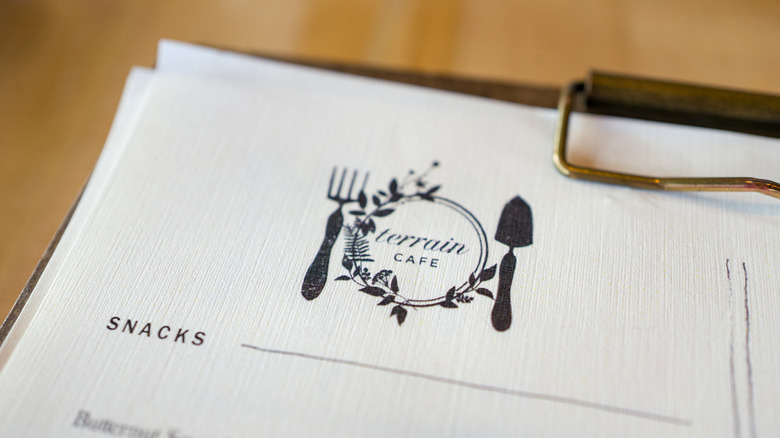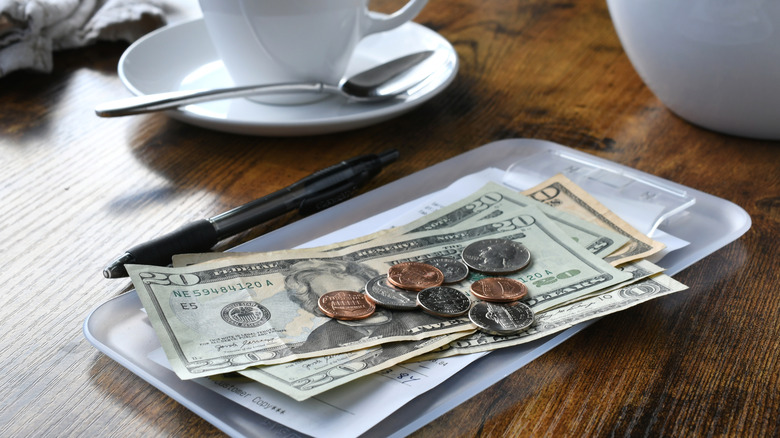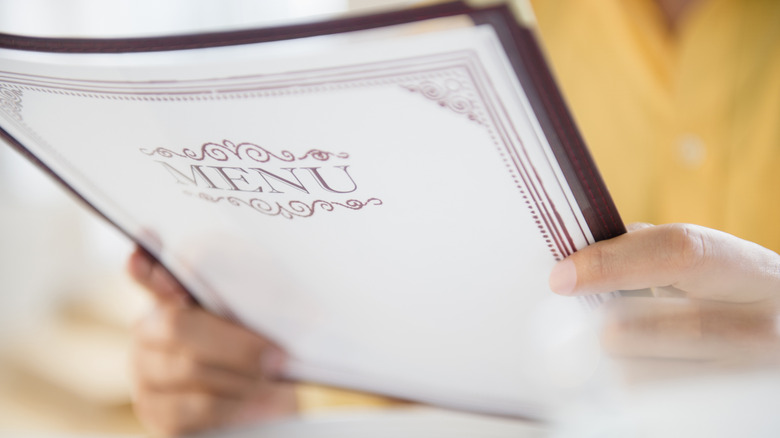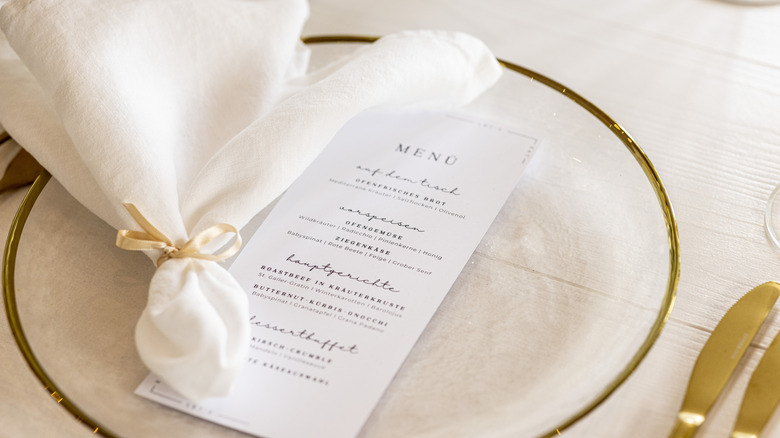How Something As Simple As Menu Design Makes You Spend More At Restaurants
Imagine you're opening a restaurant. You know what you're serving. You know what you're going to charge. Now, it's time to flex your graphic design skills with an attractive, enticing menu. The star? A Margherita pizza. The recipe is killer, the ingredients are fresh, and it's good for business, too: The pizza pulls a pretty profit even though it's the cheapest pie you serve. You highlight the pizza with a big banner across the top of the page, and to show customers that they're getting a deal, you change the price from $14 to $13.99 and emphasize the number with a big, bold font.
But three months in, the restaurant is a flop. Customers aren't coming back, the vibe is off, and people aren't treating the place like the romantic bistro you had in mind. And, bafflingly, the Margherita pizza isn't selling. What gives?
That carefully designed menu set you up for failure. Your first mistake? Putting a cheap option front and center. By starting with a budget-friendly pizza, you made everything else look pricy in comparison. The banner was a bad move, too: Diners tend to skip banners because they associate them with ads. As for the price? Emphasizing money gives off a tacky vibe — and, even worse, it reminds customers that they'll be shelling out at the end of the meal.
What is menu psychology?
Restaurants put a lot of thought into their menus. Of course, the dish selection matters; Each offering must be simple to make and appealing to diners, while simultaneously navigating the one item chefs dread adding to the menu. Dishes should maximize profit, but leaving off a popular low-profit item like steak risks disappointing customers. Too few options make diners feel limited, but overwhelming them with entrées makes it hard to decide. Plus, too many menu options can mean chefs don't know what they're doing.
Restaurants only have a few moments to catch a customer's attention; On average, people only look at menus for as little as 109 seconds. With an easy-to-scan menu, restaurants make sure those choices are the most profitable ones.
Small restaurants learn through trial and error. But there's a whole industry of researchers, consultants, and designers who craft menus for big brands and upscale eateries. Designer Albin Seaberg introduced the idea of menu psychology in his 1971 book, "Menu Design," but the field really took off during the Great Recession beginning in 2007. As casual dining — a booming business during the early aughts — felt the pinch, chains hired consultants to figure out new ways to get cost-conscious customers to open their wallets. Now, menu engineering is a lucrative business.
Graphic design is the best thing on the menu
When scanning a menu, we tend to start towards the middle of the page. From there, our eyes float to the top right corner, then left. Finally, we scan down to the bottom of the page in a Z or X formation. Customers favor the foods they see first, so the biggest stars get top billing.
While banners are bad, boxes help catch your attention. If you notice that some dishes are boxed off from the rest, they're probably moneymakers. Photos draw the eye, too — but they're risky. An unappealing photo turns customers off, but a glamour shot sets unrealistic expectations. Plus, photo menus have a cheap reputation. Upscale restaurants often opt for drawings, instead, to achieve the same effect with a classier vibe.
Font influences your decisions, too. Diners associate italics with quality. Round typefaces are linked to sweet tastes, while angular ones seem salty or sour. Up the font size, and customers spend more. Even the physical feel of the menu has an impact. The first thing diners notice about a menu — even before they start to scan the page — is the way it feels in their hand. Heavier menus are associated with fine dining. An oversized menu crowds the table and feels uncomfortable to hold. Ever wonder why restaurants have separate dessert menus? Diners buy more apps if they're not thinking about dessert when they order.
Decimal points and decoy duck dishes
See that $60 duck dish on the menu? That's a decoy. Expensive items make everything else look cheap — and add an upscale air. Some restaurants don't even really intend to sell those decoys at all. Customers rarely order the most expensive items on the menu, but the cheapest items are low sellers, too. It's just one way that restaurants play with price to manipulate customers.
You've probably noticed that some restaurants skip the dollar sign. Instead of $19, the menu will list the price as a clean, simple number 19. That's not just for design. Studies show that it makes customers spend more, since dollar signs make us think about money. Writing the price out helps, too. Numbers stand out, but words disappear into the description. Just don't use the word "dollars." It shocks customers back to reality.
Industry advisors recommend nixing decimals. It doesn't matter that $19.00 means the same thing as $19; Customers see the extra digits and get scared. Sometimes, those cents help sales, though. Upscale restaurants favor whole numbers, but fast food joints profit off a discount image. We associate prices ending in pennies with good deals — and folks still fall for the age-old .99 trick. But we're not total chumps: Along the way, the number earned a shady reputation. The solution? Drop another four cents to get better results when prices end in .95.
Convince 'em with copy
According to one study, carefully crafted descriptions bump sales by 27% percent. "Caramelized beef bulgogi with cucumber kimchi and creamy sesame sauce" doesn't just sound mouthwatering; Descriptive words literally make you salivate. For extra points, restaurants use words that make you move your mouth in a chewing motion.
People are suckers for family recipes, too. Was Grandma Mabel really famous for her vegan sous vide steaks? Probably not, but it sure sounds delicious! Plus, tacking on extra words makes for better sales. Long descriptions make customers feel like they're getting their money's worth. Words like "organic," "slow-cooked," "grass-fed," and "infused" evoke quality. If you notice that one description is longer than the rest, it's probably something the restaurant wants you to buy. In addition to intriguing customers, a long description on a page full of shorter ones stands out visually.
Foreign words are a double-edged sword. Customers stay away from foods they can't pronounce; Nobody wants to embarrass themselves in front of a suave server or a hot date. However, adventurous eaters love to feel like they're getting the real deal. A restaurant serving "moqueca" seems more authentic than one serving "Brazilian fish stew," even if the recipes are exactly the same. Some restaurants add pronunciation guides so customers can order with confidence. Others pick and choose their translations. They'll keep famous or easy-to-pronounce dishes as-is, but translate trickier words.
Menu design isn't everything
For the most part, these rules aren't set in stone. Cheesecake Factory's 20-plus page menu breaks every rule in the book. Founder David Marshall Overton admits that he knew nothing about menu design when he started the chain in 1978. Overton assumed that more options would mean more customers, and surprisingly, it worked. Now, the chain is seen as a place where big groups can go when they can't decide on a restaurant. Plus, the mile-long menus make customers turn to their servers for advice. From there, servers can upsell items.
Many of these menu tricks also come and go with trends. Words that once intrigued diners start to seem passé. A missing dollar sign didn't always signal fine dining; The trend just started in high-class establishments. QR code menus reassured diners at the height of the pandemic, but now restaurants get more sales with paper menus.
Of course, even the most brilliant menu design can only take you so far. A restaurant can't trick you into ordering an anchovy and oyster spread if you hate anchovies and oysters. That's not good business, anyway. Restaurants want to keep you happy, and customers won't be back if they feel cheated, overcharged, or unsatisfied. Just use a critical eye — you might get a good deal or find a new favorite food in an unexpected place.
